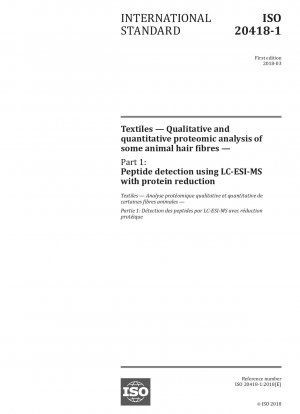ISO 20418-1:2018
Textiles - Qualitative and quantitative proteomic analysis of some animal hair fibres - Part 1: Peptide detection using LC-ESI-MS with protein reduction
- Standard No.
- ISO 20418-1:2018
- Release Date
- 2018
- Published By
- International Organization for Standardization (ISO)
- Latest
- ISO 20418-1:2018
- Scope
- This document specifies a qualitative and quantitative testing method to determine the content of wool, cashmere, yak fibres and their blends in textiles by microscope preliminary screening, protein extraction, enzymatic digestion and specific peptides detection using a liquid chromatography-mass spectrometer equipped with electrospray ionization source (LCI-ESI-MC). This method can be applied to relevant textile products at each process stage (i.e. from raw material to garment) with a homogeneous distribution of the components. It can be applied to different types of textile materials (e.g. staples, tops, yarns and fabrics) that contain wool, cashmere or yak fibres and their blends. The method is based on a preliminary identification of all fibres in the blend on the basis of their morphology, by light microscopy. The proteins are then extracted by a thiourea/urea/dithiothreitol (DTT) solution. An enzymatic digestion by trypsin of the protein extracted from the fibres is carried out. Analysis of the specific markers is performed by LC-MS and the percent composition is calculated. This method is applicable to samples containing other kinds of fibres than wool, cashmere and yak, by combining its results with the results obtained using the ISO 1833 series and/or the ISO 17751 series. This document does not apply if fibres of the same animal species are present (e.g. blends of cashmere and mohair); in this case, the quantitative analysis can be performed using microscopic analysis (e.g.
ISO 20418-1:2018 Referenced Document
- ISO 137:2015 Wool - Determination of fibre diameter - Projection microscope method
- ISO 1833-10:2006 Textiles - Quantitative chemical analysis - Part 10: Mixtures of triacetate or polylactide and certain other fibres (method using dichloromethane)
- ISO 1833-11:2017 Textiles — Quantitative chemical analysis — Part 11: Mixtures of cellulose and polyester fibres (method using sulfuric acid)
- ISO 1833-12:2006 Textiles - Quantitative chemical analysis - Part 12: Mixtures of acrylic, certain modacrylics, certain chlorofibres, certain elastanes and certain other fibres (method using dimethylformamide)
- ISO 1833-13:2006 Textiles - Quantitative chemical analysis - Part 13: Mixtures of certain chlorofibres and certain other fibres (method using carbon disulfide/acetone)
- ISO 1833-14:2006 Textiles - Quantitative chemical analysis - Part 14: Mixtures of acetate and certain chlorofibres (method using acetic acid)
- ISO 1833-15:2006 Textiles - Quantitative chemical analysis - Part 15: Mixtures of jute and certain animal fibres (method by determining nitrogen content)
- ISO 1833-16:2006 Textiles - Quantitative chemical analysis - Part 16: Mixtures of polypropylene fibres and certain other fibres (method using xylene)
- ISO 1833-17:2006 Textiles - Quantitative chemical analysis - Part 17: Mixtures of chlorofibres (homopolymers of vinyl chloride) and certain other fibres (method using sulfuric acid)
- ISO 1833-18:2006 Textiles - Quantitative chemical analysis - Part 18: Mixtures of silk and wool or hair (method using sulfuric acid)
- ISO 1833-19:2006 Textiles - Quantitative chemical analysis - Part 19: Mixtures of cellulose fibres and asbestos (method by heating)
- ISO 1833-1:2006 Textiles - Quantitative chemical analysis - Part 1: General principles of testing
- ISO 1833-20:2009 Textiles - Quantitative chemical analysis - Part 20: Mixtures of elastane and certain other fibres (method using dimethylacetamide)
- ISO 1833-21:2006 Textiles - Quantitative chemical analysis - Part 21: Mixtures of chlorofibres, certain modacrylics, certain elastanes, acetates, triacetates and certain other fibres (method using cyclohexanone)
- ISO 1833-22:2013 Textiles - Quantitative chemical analysis - Part 22: Mixtures of viscose or certain types of cupro or modal or lyocell and flax fibres (method using formic acid and zinc chloride)
- ISO 1833-24:2010 Textiles - Quantitative chemical analysis - Part 24: Mixtures of polyester and certain other fibres (method using phenol and tetrachloroethane)
- ISO 1833-25:2013 Textiles.Quantitative chemical analysis.Part 25: Mixtures of polyester and certain other fibres (method using trichloroacetic acid and chloroform)
- ISO 1833-26:2013 Textiles - Quantitative chemical analysis - Part 26: Mixtures of melamine and cotton or aramide fibres (method using hot formic acid)
- ISO 1833-2:2006 Textiles - Quantitative chemical analysis - Part 2: Ternary fibre mixtures
- ISO 1833-3:2006 Textiles - Quantitative chemical analysis - Part 3: Mixtures of acetate and certain other fibres (method using acetone)
- ISO 1833-4:2017 Textiles - Quantitative chemical analysis - Part 4: Mixtures of certain protein fibres with certain other fibres (method using hypochlorite)
- ISO 1833-5:2006 Textiles - Quantitative chemical analysis - Part 5: Mixtures of viscose, cupro or modal and cotton fibres (method using sodium zincate)
- ISO 1833-6:2007 Textiles - Quantitative chemical analysis - Part 6: Mixtures of viscose or certain types of cupro or modal or lyocell and cotton fibres (method using formic acid and zinc chloride)
- ISO 1833-7:2017 Textiles — Quantitative chemical analysis — Part 7: Mixtures of polyamide and certain other fibres (method using formic acid)
- ISO 1833-8:2006 Textiles - Quantitative chemical analysis - Part 8: Mixtures of acetate and triacetate fibres (method using acetone)
- ISO 1833-9:2006 Textiles - Quantitative chemical analysis - Part 9: Mixtures of acetate and triacetate fibres (method using benzyl alcohol)
- ISO 2647:1973 Wool; Determination of percentage of medullated fibres by the projection microscope
- ISO 5725-2:1994 Accuracy (trueness and precision) of measurement methods and results - Part 2: Basic method for the determination of repeatability and reproducibility of a standard measurement method
- ISO/TR 11827:2012 Textiles - Composition testing - Identification of fibres
ISO 20418-1:2018 history
- 2018 ISO 20418-1:2018 Textiles - Qualitative and quantitative proteomic analysis of some animal hair fibres - Part 1: Peptide detection using LC-ESI-MS with protein reduction
